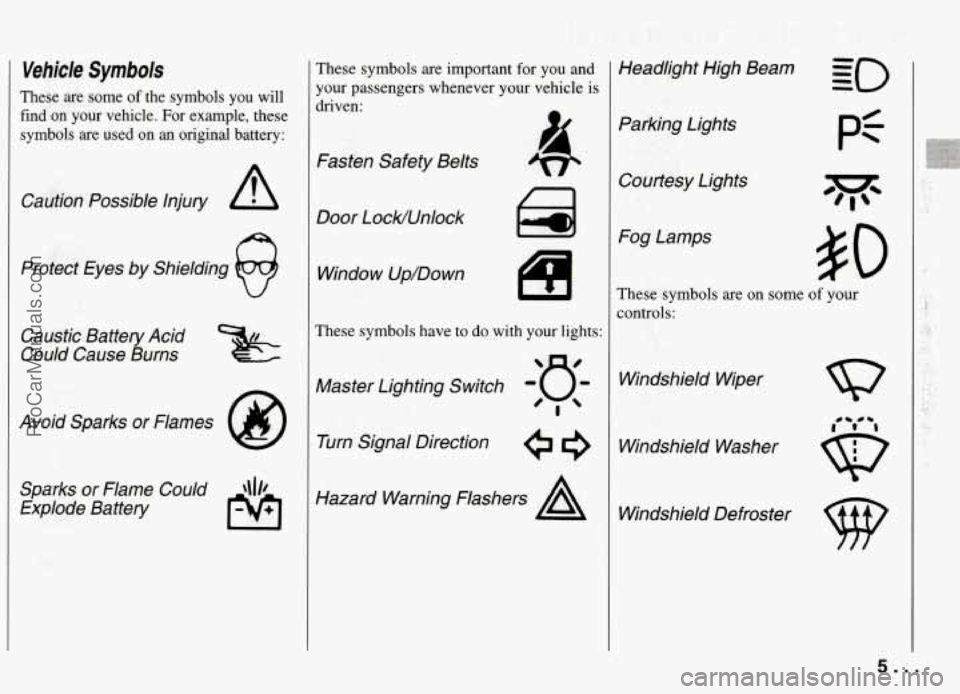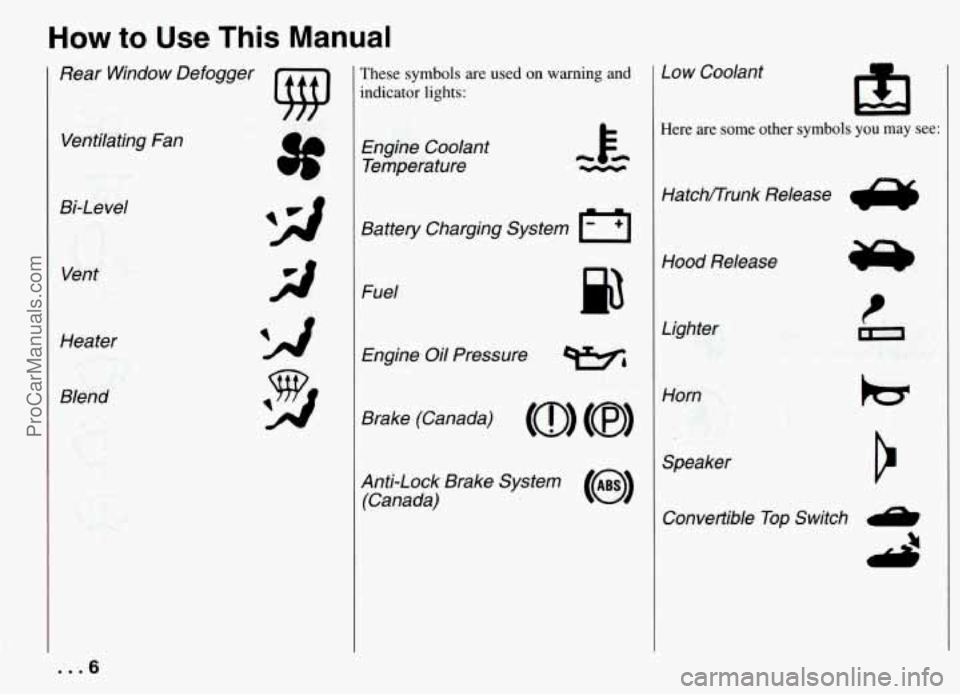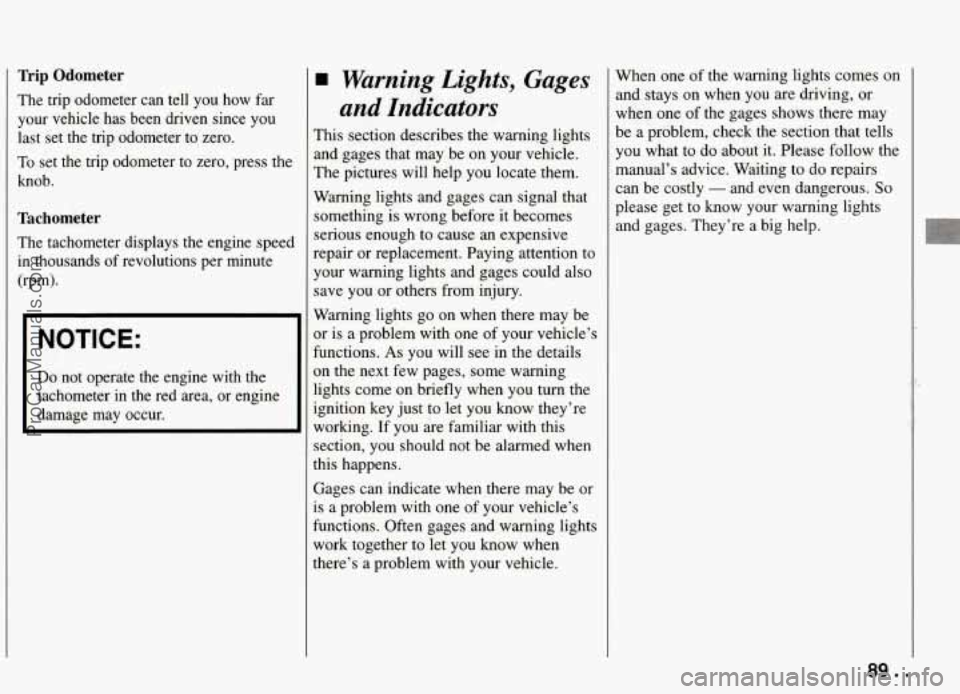warning light PONTIAC FIREBIRD 1994 Owners Manual
[x] Cancel search | Manufacturer: PONTIAC, Model Year: 1994, Model line: FIREBIRD, Model: PONTIAC FIREBIRD 1994Pages: 290, PDF Size: 14.84 MB
Page 6 of 290

Vehicle Symbols
These are some of the symbols you will
find on your vehicle. For example, these
symbols are used on
an original battery:
Caution Possible Injury A
Protect Eyes by Shielding
@
Caustic Battery Acid
Could Cause Burns
Avoid Sparks or Flames
8
Sparks or Flame Could \\b
Explode Battery m
These symbols are important for you and
your passengers whenever your vehicle is
driven:
Fasten Safety Belts
Door LocWUnlock Window Up/Down
a
These symbols have to do with your lights:
Master Lighting Switch
Turn Signal Direction
Hazard Warning Flashers
A
A
Headlight High Beam
Parking Lights
Courtesy Lights
Fog Lamps
These symbols are on some of your
controls:
Windshield Wiper
Windshield Washer
Windshield Defroster
5..
ProCarManuals.com
Page 7 of 290

How to Use This Manual
Rear Window Defogger
Y
Ventilating Fan
Bi-
L e vel
Vent
Heater Blend
These symbols are used on warning and
indicator lights:
Engine Coolant
Temperature
Battery Charging System
1-7
Fuel
Engine
Oil Pressure w,
Brake (Canada) (0) (8)
Anti-Lock Brake System
(Canada) Low Coolant
m
Here
are some other symbols you may see:
Hatchnrunk Release a
Hood Release
Lighter
Horn
Speaker Convertible Top Switch
... 6
ProCarManuals.com
Page 42 of 290

Here you can learn about the
many standard and optional
features on your Pontiac.
And
information on starting. shifting
and braking
. Also explained are
the instrument panel and the
warning systems that tell you
if
everything is working properly
- and what to do if you have a
problem
.
Keys .......
Door Locks . .
Part 2
Features & Controls
....................................................
....................................................
Theft and Theft Deterrents ...........................................
New Vehicle “Break-In” ............................................
Ignitionswitch ....................................................
Automatic Transmission ............................................
ManualTransmission ...............................................
Limited-Slip Rear Axle .............................................
Parking ..........................................................
EngineExhaust ...................................................
Windows ........................................................
Horn ............................................................
Tiltwheel ........................................................
The Turn Signal/Headlight Beam Lever ................................
Mirrors ..........................................................
Twin Lift-off Roof Panels ...........................................
Storage and Compartments ..........................................
SunVisors .......................................................
AshtrayandLighter ................................................
Instrument Panel and Cluster .........................................
ConvertibleTop ...................................................
Starting Your Engine ...............................................
Operation of Lights ................................................
42
43
48
50
51
52
56
59
62
63
66
67
68
69
69
76
79
SO
83
85
85
89
98
41 ...
ProCarManuals.com
Page 52 of 290

D
Ignition Switch
With the ignition key in the ignition
switch, you can
turn the switch to five
positions:
Acc (A): Position in which you can
operate your electrical power accessories.
Press in the ignition switch as you
turn
the top of it toward you.
LOCK (B): The only position in which
you can remove the key. This locks your
steering wheel, ignition and automatic
transmission.
If you have an automatic transmission,
tht
ignition switch can’t be turned to
“LOCK’ unless the shift lever is in the
“P’ (Park) position.
Off (C): Unlocks the steering wheel,
ignition and automatic transmission, but
does not send electrical power to any
accessories. Use this position if your
vehicle must be pushed or towed. A
warning tone will sound if you open the
driver’s door when the ignition is in
“Off”
and the key is in the ignition.
Run (D): Position to which the switch
returns after you start your engine and
release the switch. The switch stays in the
“Run” position when the engine is
running. But even when the engine is not
running, you can use “Run” to operate
your electrical power accessories and to
display some instrument panel warning
and indicator lights.
Start (E): Starts the engine. When the
engine starts, release the key. The ignition
switch will return to “Run” for normal
driving.
Note that even if the engine is not
running, “Acc” and “Run” allow you to
operate your electrical accessories, such
as the radio and ventilation fan.
:I
Ley Release Button: If you have a
lanual transmission, your ignition lock
as a key release button.
You must press
le button before you can take your key
ut of the ignition lock.
51 . .
ProCarManuals.com
Page 64 of 290

Parking
Parking Brake
The parking brake uses the brakes on the
rear wheels.
To set the parking brake: Hold the brake
pedal down and pull up on the parking brake lever. If the ignition is on, the brake
system warning light will come on.
To release the parking brake: Hold the
brake pedal down.
Pull the parking brake
lever up until you can push in the release
button. Hold the release button in as you
move the brake lever all the way down.
NOTICE:
Driving with the parking brake on
can cause your rear brakes to over-
heat. You may have to replace them,
and you could also damage other
parts of your vehicle.
If you are towing a trailer and are
parking on any hill:
See “Towing a
Trailer” in the Index. That section shows
what to do first to keep the trailer from
moving.
63 ...
ProCarManuals.com
Page 90 of 290

Trip Odometer
The trip odometer can tell you how far
your vehicle has been driven since you
last set the trip odometer to zero.
To set the trip odometer to zero, press the
knob.
Tachometer
The tachometer displays the engine speed in thousands of revolutions per minute
(rpm).
I NOTICE:
I
Do not operate the engine with the
tachometer in the red area, or engine
damage may occur.
Warning Lights, Gages
and Indicators
This section describes the warning lights
and gages that may be on your vehicle.
The pictures will help you locate them.
Warning lights and gages can signal that
something is wrong before
it becomes
serious enough to cause
an expensive
repair or replacement. Paying attention to
your warning lights and gages could also
save you or others from injury.
Warning lights go on when there may be
or is a problem with one of your vehicle’s
functions.
As you will see in the details
on the next few pages, some warning
lights come on briefly when you turn the
ignition key just to let you know they’re
working. If you are familiar with this
section, you should not be alarmed when
this happens.
Gages can indicate when there may be or
is a problem with one of your vehicle’s
functions. Often gages and warning lights
work together to let you know when
there’s a problem with your vehcle. When
one of the warning lights comes on
and stays on when you are driving, or
when one
of the gages shows there may
be a problem, check the section that tells
you what to do about it. Please follow the
manual’s advice. Waiting to do repairs
can be costly
- and even dangerous. So
please get to know your warning lights
and gages. They’re a big help.
89. .
ProCarManuals.com
Page 91 of 290

Features and Controls
Fuel Gage
four fuel gage shows about how much
bel is in your tank. The fuel gage works
mly when the ignition switch is in the
‘Run” position. When the gage pointer
‘Irst indicates
“E,” you still have a little
uel left (about one to two gallons), but
IOU need to get more right away.
3ere are four concerns some owners
lave had about the fuel gage. All these
iituations are normal and do not indicate
:hat anything is wrong with the fuel gage.
,..go
At the gas station, the gas pump shuts
off before the gage reads “E”
It takes more (or less) gas to fill up
than the gage reads. For example, the
gage reads
1/2 full, but it took more
(or less) than half of the tank’s
capacity to fill it.
The gage moves
a little when you
turn, stop or speed up.
When you turn the engine
off, the
gage doesn’t go back to
“E.”
Brake System Warning Light
Your Pontiac’s hydraulic brake system is
divided into two parts. If one part isn’t
working, the
other part can still work and
stop you. For good braking, though, you
need both pws working well.
If the warning light comes on, there could
be a brake problem. Have your brake
system inspected right away.
This light should come on as you start the
vehicle. If it doesn’t come on then, have
it
fixed so it will be ready to warn you if
there’s a problem.
ProCarManuals.com
Page 92 of 290

If the light comes on while you are driving, pull
off the road and stop
carefully.
You may notice that the pedal is
harder to push. Or, the pedal may
go
closer to the floor. It may take longer to
stop. If the light is still on,
or if the
anti-lock brake system warning light is
flashing, have the vehicle towed for
service. (See “Anti-Lock Brake System
Warning Light” and “Towing Your
Vehicle” in
the Index.) The brake
system warning light will also
come on when you set your parlung
brake, and it will stay on if your parking
brake doesn’t release fully. If
it stays on
after your parking brake
is fully released,
it means
you have a brake problem.
Anti-Lock Brake System Warning
Light
With anti-lock, this light will come on
when you start your engine and it will
stay on for three seconds. That’s normal.
If the light doesn’t come on, have it fixed
so it will be ready to warn you if there is a
problem.
If the light flashes when you’re driving,
you don’t have anti-lock brakes and
there’s a problem with your regular
brakes. Pull
off the road and stop
carefully.
You may notice that the pedal is
harder to push. Or, the pedal may go
closer to the floor. It may take longer to
stop. Have the vehicle towed for service.
(See “Towing
Your Vehicle” in the
Index.)
91 ...
ProCarManuals.com
Page 93 of 290

Features and Controls
-
I
1:
4
i;
S
S
1
S
C
s
C
S
1
t
... 92
ABS
INOP
f the anti-lock brake system warning
ight stays on longer than normal after
rou’ve started your engine, turn the
gnition
off. Or, if the light comes on and
tays on when you’re driving, stop as
oon as possible and turn the ignition
off.
rhen start the engine again to reset the
‘ystem. If the light still stays on, or
:omed on again while you’re driving,
rour Pontiac needs service. If the light is
In but not flashing and the regular brake
,ystem warning light isn’t on, you still
lave brakes, but you don’t have anti-lock
wakes.
TCS
OFF
kaction Control System Warning
,ight (Option)
men the traction control system is off,
he “TCS OFF” light will come on. This
ight will also come on for three seconds
:ach time you start your vehicle as a bulb
:heck and if there’s a system failure. See
‘Traction Control System” in the Index.
The traction control system will shut
lown partially due to brake overheating
)ut the “TCS OFF” light will not come
m. If there is throttle relaxer overheating,
he “TCS
OFF” light will illuminate
md the system will shut down. Once
werything cools
off, the system will
)perate normally again.
ProCarManuals.com
Page 94 of 290

When this warning light is on, the system
will not limit wheel spin. Adjust your
driving accordingly.
Low Traction Light
When your anti-lock system is adjusting
brake pressure to help avoid a braking
skid, the “LOW TRAC” light will appear
on your instrument cluster. If you have
the traction control system, this light will
also come on when the system is limiting
wheel spin. Slippery road conditions may
exist if this light comes on,
so adjust your
driving accordingly. The light will stay
or
for a few seconds after the anti-lock
system stops adjusting brake pressure or
the traction control system stops limiting
wheel spin. The “LOW TRAC” light also
comes
on briefly, as a bulb check, when
the engine is started.
Sngine Coolant Temperature Gage
’his gage shows the engine coolant
emperature.
If the gage pointer moves
nto the red area, your engine is too, hot!
t means that your engine coolant fias
werheated. If you have been operiting
‘our vehicle under normal driving-
onditions, you should pull off the road,
top your vehicle and turn
off the engine
s soon as possible.
IOT COOLANT CAN BURN
YOU
iADLY!
n “Problems on the Road,” this manual
hows what
to do. See “Engine
Iverheating” in the Index.
93 ...
ProCarManuals.com